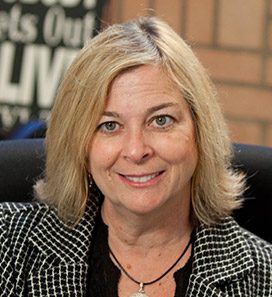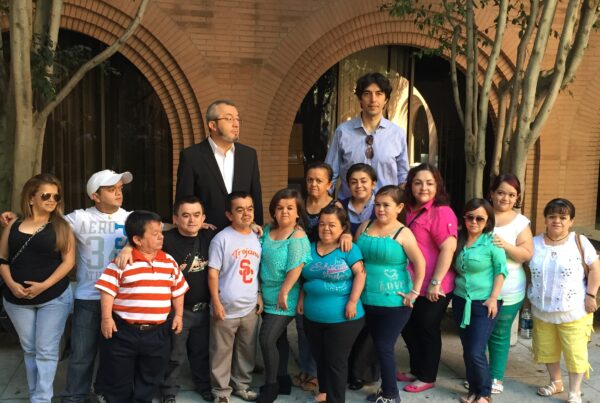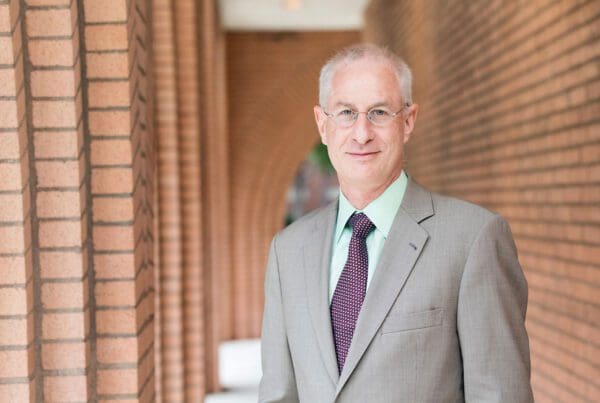On a sunny day in early July 2022, just two weeks short of her 94th birthday, Lydia Sloan could be found in her favorite place—the flourishing garden of her Palo Alto home, pruning bushes and picking tomatoes for the dinner she would make that night.
She had lived here for more than six decades with her husband, Charles, until his passing several years earlier. Together, they raised three children in the town in which she grew up and graduated from Stanford University, where they met.
Strong-minded and determined to make it on her own, Sloan regularly exercised her passions for reading, gardening and family. But that independent life was about to change.
Suddenly, she lost her balance and fell. She hit the ground hard, breaking multiple bones, including her clavicle and her femur in four places. It took two hours, pushing herself on her back, to return to her house to call 911.

From left to right: Margaret (Blue) Tierney, Charles Sloan, Lydia Sloan
Over the coming few months, Sloan was in increasing back pain. At first, doctors suspected her injuries and long-standing scoliosis of the spine. After four visits to the emergency room, she finally got a diagnosis: uterine cancer.
“My mother had enjoyed the gift of health her whole life,” says her eldest daughter, Margaret (Blue) Tierney. “She wasn’t prepared for this. Neither were we.”
The family would soon learn a new phrase—palliative care. Though unfamiliar, it would wrap a compassionate, useful embrace around them all when they needed it most.
Discovering a Valuable Resource
Palliative care is a largely misunderstood and under-utilized resource often confused with its better-known cousin, hospice care. “It’s considered an extra layer of support—at any stage for any age,” says Susan Enguídanos, Associate Professor of Gerontology at the USC Leonard Davis School of Gerontology.
Widely renowned in the field of palliative care, she has spent decades studying its effectiveness and benefits—and trying to remove barriers to its usage.
Palliative care flies under the radar of many patients who could benefit from it and even a majority of physicians. If you search online for “palliative care,” what often comes up is “hospice” or “end-of-life care.” Neither is accurate. “One of the things we know from research is that a lot of people conflate the terms,” says Enguídanos.
In California, and elsewhere, many hospice organizations also provide palliative services, compounding the confusion. Television medical dramas don’t help.
“Many people get their healthcare information from TV,” says Deborah Fui-Yuen Hoe, an instructional assistant professor for Gerontology who collaborates in the Enguídanos Lab. “Very few medical series mention palliative care and those that do often get it wrong.”
What Palliative Care Is & Isn’t
At its most basic, palliative care is support for people with serious chronic or complicated illnesses. It can start as early as the day of diagnosis. Hospice care comes in when a patient has a terminal illness with six months or less to live.
Patients must forego curative care in hospice, while palliative care can be provided alongside other medical treatments. Whether or not a cure is anticipated, palliative’s focus is on pain relief and other physical, psychosocial and spiritual support for patients and families.
In palliative’s home-based interdisciplinary approach, each team includes a physician, nurse, social worker, chaplain and home health aide. Enguídanos developed and tested this home-based palliative care model in two pivotal research studies published in 2002 and 2007 and conducted in Kaiser Permanente HMOs in California, Colorado and Hawaii.
The 2007 clinical trial enrolled more than 300 seriously ill patients. Its findings: patients receiving home-based palliative care had fewer emergency department visits, inpatient hospital days, skilled nursing days and physician office visits than patients on usual medical care.
With more home visits than typical, home-based palliative care patients experienced a far lower cost of care— 37% to 45% below standard care. And they were more likely to die at home, a place most people prefer to be at end of life.
Quick Learning Curve Required
Blue Tierney didn’t know these statistics in the summer of 2022. She only knew she had to act quickly. Independent even now, her mother still wanted a place of her own. So, Tierney and her husband, Phil, moved her to an assisted living facility close to their home in Placerville in the Sierra Foothills.
The Tierneys had one advantage: they come from a medical family, with a son who is a head and neck surgeon, one daughter-in-law an endocrinologist and another in residency in emergency medicine. Their son gave them his prescription for his grandmother, “She needs palliative care.”
The Tierneys weren’t sure what that was. They went to Sloan’s primary care doctor, but he couldn’t make any referrals.
Phil Tierney set to work. “First, I looked for palliative care doctors or doctors with it in their portfolio. I identified three in our area—it seemed pretty sparse,” he says. In an amazing synchronicity, the Tierneys found what they needed in a nonprofit organization they and Sloan had supported as donors—Snowline in El Dorado County.
“We didn’t realize Snowline provided palliative care,” says Blue Tierney. “Everyone here thinks of it as hospice.”
Palliative care’s identity problem is why Snowline has stopped using “hospice” in its name and why its medical director, Jeanine Ellinwood, prefers to call it “supportive” care.
Ellinwood began working in hospice in 1998, “before palliative care had branched into its own entity,” she says. Then, in 2010, a landmark study published in the New England Journal of Medicine, showed that for patients with metastatic non-small-cell lung cancer, early palliative care led to significant improvements in quality of life, as well as longer survival. “That got attention from the medical profession.”
Ellinwood and Enguídanos have collaborated on palliative care studies that focus on expanding access to care and understanding challenges in accessing care from multiple perspectives.
360 Degrees of Support
Palliative care can provide a wide range of services and supports, including expert pain management, medication reminders, wound and oxygen care or help with medical equipment, insurance paperwork, care planning, food and housing support, everyday chores, like trash collection, that have become difficult to manage—even spiritual issues.
Ellingwood recalls one patient in her mid-50s with lung cancer whose primary care doctor had labeled “non-compliant.” Her Snowline palliative care team discovered she was worried about eviction because her medical equipment blocked her apartment building’s hallway and about her 14-year-son’s reaction to her illness.
The team nurse spoke to the landlord about allowing the equipment, while the social worker arranged for additional school support. Now the patient could focus on healing. “We walk alongside each patient whatever their goals,” says Ellinwood.
She believes acceptance of palliative care has grown in the last several years. “Physicians are starting to have a better understanding. Things are changing but slowly.”
For Enguídanos, that progress has been too slow.

Associate Professor Susan Enguidanos
Unlike hospice, home-based palliative care is still not a Medicare benefit and “not broadly provided across the country,” she says. In 2018, the State of California enacted Senate Bill 1004, which mandates that providers of Medi-Cal (the state’s Medicaid health care program) offer team-based, coordinated palliative care to eligible patients with serious illnesses.
But, in a 2020 study, Enguídanos, Hoe and others characterized the response from primary care physicians to the expanded coverage as “underwhelming.” In the two years following enactment of SB 1004, fewer than 1% of all Medi-Cal patients were enrolled in home- and community-based palliative care programs. Most doctors surveyed had not even heard of the coverage.
Also discouraging: Anecdotal reports suggest that of the Medi-Cal patients who were referred to home-based palliative care, less than half enrolled.
What prevents physicians and patients from signing up for services that have been proven to increase comfort and quality of life? In multiple studies, Enguídanos’s team has analyzed possible barriers from every angle—providers, patients and caregivers.
Discomfort, Worry & Resistance
One explanation: Many people shy away from conversations about illness, dying and end of life—“and that includes physicians,” says Hoe. “Our surveys have found many doctors are not comfortable talking about the issue or they wait for patients to bring it up.”
Often, physicians aren’t sure how to explain palliative care. Some interpret it as a failure of their own treatment plans.
Patients have their own uncertainties. “They oftentimes don’t know what palliative care is or feel they are not sick enough,” says Enguídanos. “Or they are already so overwhelmed by their health issues and related appointments, they don’t understand the value of having another team of providers managing their care.”
In addition, some patients don’t want strangers in their homes or, depending on their immigration status, may worry about “authorities” stepping in.
Complicating this picture are cultural differences. In some languages, there is no direct translation for “palliative care” or the term carries negative connotations. In Mandarin, for example, palliative translates as “last-minute care” or “waiting for death.”
For patients struggling with financial, food and/or housing instability having palliative care’s “extra level of support,” even if covered by insurance, may not be the highest priority. “They are dealing with 101 other things and may not know how to ask for help or even what to ask for,” says Enguídanos. In a 2022 study, her team evaluated ways to increase palliative care to low-income patients in California, concluding culturally sensitive education is essential.
A Team Takes Charge
Sloan’s cancer spread to her abdomen and she opted for chemotherapy. The first round had little effect and she decided to try a second. She became so dizzy, she couldn’t get out of bed and suffered another bad fall. At that point, “there were just too many people involved in her care,” says Tierney. “We needed help. We needed structure.”
The Snowline team stepped in, assisting with insurance paperwork and care decisions. Nurse practitioner Deborah Cheever took the lead in adjusting Sloan’s pain meds. “Sometimes, families don’t know what to ask for. We help them navigate and identify their goals,” says Cheever.
Lydia Sloan and her family, including daughter Catherine and son David, knew what they wanted—guidance. Sloan was able to call Snowline with her own questions. “I also had someone I could talk to anytime,” says Tierney. “With so much knowledge on the team, there is information and emotional support.”
When the time came for Sloan to enter hospice care, that transition was easier. On June 8, she passed quietly in her sleep.
Going forward, Enguídanos and her team are looking at the impact of race on access to palliative care, along with the effectiveness of video as an educational tool. Another line of inquiry is whether enrollment would grow if physicians and nurses provide patients with a “warm handoff” to a palliative care social worker instead of a less personal referral.
There are positive developments on the horizon. Hawaii is close to following California’s example and approving Medicaid reimbursements for palliative care. A growing number of insurers, health plans and medical groups offer the care, and home-based palliative care is gaining ground. “It’s exciting to see some of our early work adapted into standard practice after all this time,” says Enguídanos. “Especially considering the extensive evidence of the value of this service to patients and their family members.”
One caregiver emphatically agrees. As Tierney says: “Palliative care is a public health necessity.”





